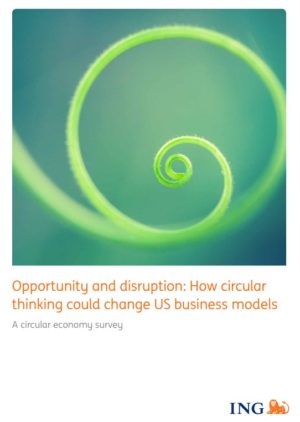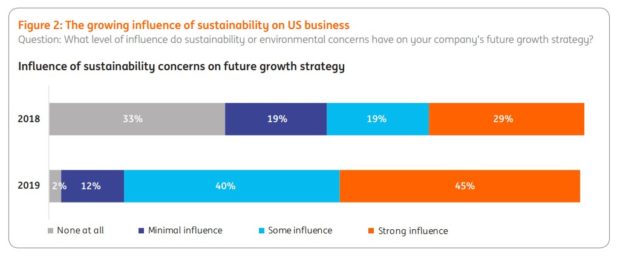In 2018, ING surveyed 200 US executives and found that sustainability is now a well-established feature on the US corporate agenda, with companies with more mature initiatives seeing it as a revenue driver. This year, ING took our survey further and focused on sustainability in action by looking at the approaches US firms are undertaking to embed practices within their business models. In the ongoing effort of ING to support sustainable business initiatives, the bank surveyed 300 US executives across four sectors (automotive, consumer electronics/telecoms, food/agriculture, and healthcare) to discuss the shift to adopt an entirely new model that houses sustainability at its core – the circular economy.
 Traditional businesses have operated under ‘linear’ economic models that ‘take, make, use and waste’ materials. The structure of the circular economic model focuses on businesses developing innovative propositions for customers that enable them to use products for longer, return or replace products or even share a product with other consumers. This process leads to a new type of relationship between business and customer; one that is less transactional, more long-term and solution led.
Traditional businesses have operated under ‘linear’ economic models that ‘take, make, use and waste’ materials. The structure of the circular economic model focuses on businesses developing innovative propositions for customers that enable them to use products for longer, return or replace products or even share a product with other consumers. This process leads to a new type of relationship between business and customer; one that is less transactional, more long-term and solution led.
The research found the circular economy is increasingly on the agenda, but US firms are struggling to understand its true value and implement it effectively. Encouragingly, interest is growing; ING’s research shows that while only 16% of US businesses have adopted the circular economic framework, 62% say moving toward this is part of their business strategy.
Here is what ING learned:
1. By prioritizing sustainability, US businesses are growing: Twice as many US firms are embedding sustainability in strategic decision making in 2019 as we saw in 2018.
There has been a marked jump in the number of executives who say that sustainability is influencing business growth strategy: 85% say this today, compared to just 48% who reported this in our 2018 study. Businesses are recognizing the benefits that sustainability strategies can provide, but there is still a lot of room to grow.
2. Businesses see a future in the circular economy: US businesses are embracing circular practices – even if in a fragmented fashion.
Even though only 16% of US firms say they have adopted a circular economy framework today, there is strategic intent to do so from 62% of the businesses we surveyed.
There are a substantial number of circular-type initiatives underway across the production cycle, and a lesser number to transform product models, demonstrating that circular thinking is becoming increasingly relevant in the US
3. But businesses are struggling to unlock the full value of circular: For businesses in the US, circular remains a story of unidentified value. Current perceptions about circular practices will need to evolve to help US firms reap circular rewards and respond to business disruption.
Most US businesses we surveyed are focusing on cost-saving aspects of circular initiatives rather than the value retention and creation that can be achieved through closing material loops. A minority of firms with more advanced circular strategies say that responding to evolving consumer trends is a key driver for them to pursue circular initiatives
4. Circular thinking requires new relationships with consumers: Our survey shows consumers are increasingly demanding circular practices, but both consumers and firms need to establish new ways to reuse and recycle products and materials.
33% of firms that have adopted a circular framework did so because of customer demand. In understanding how companies are becoming increasingly sustainable, it is clear there are parts of the model that we still need to discover and create standards of procedure for – particularly around the relationship between the company and customer. The firms we surveyed responded that “Difficulty recovering materials for recycling” was that biggest barrier to adoption of the circular economy model (32%)
5. Challenges remain, but opportunity awaits through collaboration: Successful implementation of circular models is not something a company can do by itself. To reach full potential, firms needs to work with supply chain partners, customers, financing partners and even competitors.
Work with your suppliers to assess the possibility of collaborating on circular initiatives. Explore new business relationships, with new buyers for waste materials and with cities or communities to encourage greater resource recovery — and open up potential new revenue streams. Talk to your competitors, and companies in other industries, to see if there are areas in which you could cooperate on circular solutions. And finally, work with your bank to assess whether it understands, and whether it is prepared to provide financing solutions for circular models.



